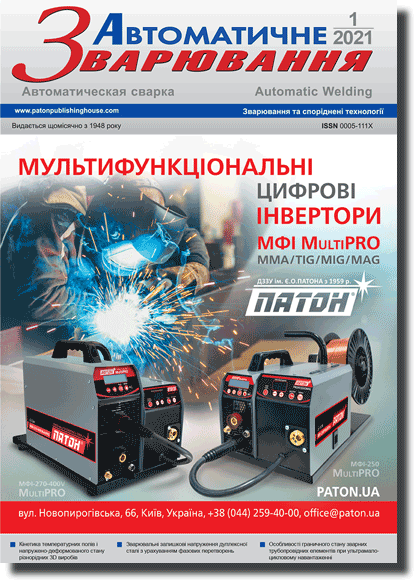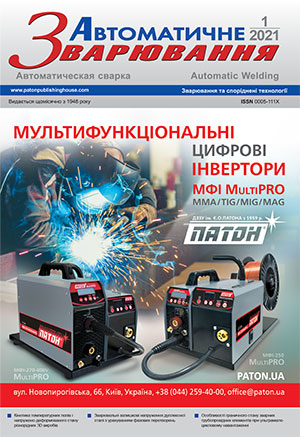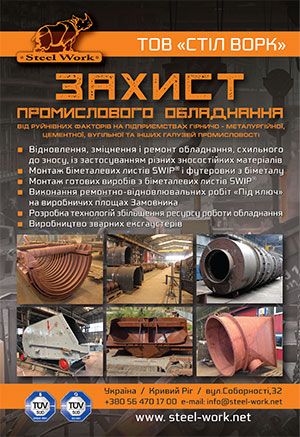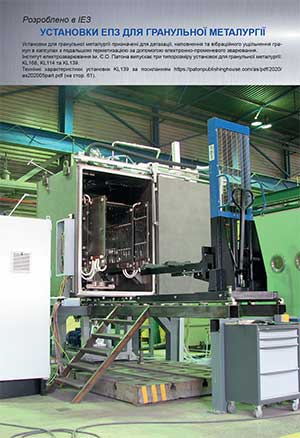| 2021 №01 (03) |
DOI of Article 10.37434/as2021.01.04 |
2021 №01 (05) |

Журнал «Автоматичне зварювання», № 1, 2021, с. 20-24
Порівняльний аналіз результатів математичного моделювання процесів тепломасообміну у металі, що зварюється, за допомогою різних програмних засобів
O.П. Семенов1, I.В. Крівцун1, А.В. Лихошва1, O.І. Глухенький2, O.І. Бондар2
1E.O. Paton Electric Welding Institute of NAS of Ukraine, 11 Kazymyr Malevych Str., 03150, Kyiv, Ukraine. E-mail: office@paton.kiev.ua
2The Institute of Electrodynamics of NAS of Ukraine, 56 Peremohy, Ave., 03057, Kyiv, Ukraine
У роботі розглянуто два програмних засоби для моделювання фізичних явищ у зварювальній ванні: COMSOL Multiphysics та власний програмний модуль, який реалізований у середовищі Wolfram Mathematica та грунтується на методі скінченних елементів. З метою валідації було розглянуто дві тестові задачі, пов’язані з термокапілярною конвекцією Марангоні. Отримані результати добре узгоджуються з наявними у літературі розв’язками вибраних тестових прикладів. Розроблені чисельні алгоритми та програмне забезпечення можуть бути використані задля розв’язання мультифізичних задач, що виникають при теоретичному дослідженні зварювальних процесів. Бібліогр. 14., табл. 1, рис. 8.
Ключові слова: конвекція Марангоні, форма зварювальної ванни, математичне моделювання, лазерне зварювання.
Надійшла до редакції 10.12.2020
Список літератури
1. Kou, S. (2002) Welding metallurgy. New Jersey, John Wiley & Sons.2. Messler, Jr., Robert, W. (2008) Principles of welding: Processes, physics, chemistry, and metallurgy. New Jersey, John Wiley & Sons.
3. Limmaneevichitr, C., Kou, S. (2000) Visualization of Marangoni convection in simulated weld pools. Welding J., 79(5), 126–135.
4. Tsai, M. C., Kou, S. (1989) Marangoni convection in weld pools with a free surface. Int. J. for Numerical Methods in Fluids, 9(12), 1503–1516.
5. Sahoo, P., Debroy, T., McNallan, M. J. (1988) Surface tension of binary metal–surface active solute systems under conditions relevant to welding metallurgy. Metallurgical Transact., B, 19(3), 483–491.
6. Heiple, C.R. (1982) Mechanism for minor element effect on GTA fusion zone geometry. Welding J., 61(4), 97–102.
7. Pitscheneder, W. et al. (1996) Role of sulfur and processing variables on the temporal evolution of weld pool geometry during multikilowatt laser beam welding of steels. Ibid., 75(3), 71–80.
8. Kou, S., Sun, D.K. (1985) Fluid flow and weld penetration in stationary arc welds. Metallurgical Transact., A, 16(1), 203–213.
9. Demchenko, V. F., Krivtsun, I. V., Krikent, I. V., Shuba, I. V. (2017). Force interaction of arc current with self-magnetic field. The Paton Welding J., 3, 15-24. DOI: https://doi. org/10.15407/as2017.03.03
10. Brent, A.D., Vaughan R. Voller, K.T.J. Reid. (1988) Enthalpyporosity technique for modeling convection-diffusion phase change: Application to the melting of a pure metal. Numerical Heat Transfer, Pt A: Applications, 13(3), 297–318.
11. Zienkiewicz, O.C., Taylor, R.L. (2000) The finite element method. Vol. 3: Fluid dynamics. Oxford, Butterworth-Heinemann.
12. Gupalo, Yu P., Ryazantsev, Yu S. (1988) Thermocapillary motion of a liquid with a free surface with nonlinear dependence of the surface tension on the temperature. Fluid Dynamics, 23(5), 752–757.
13. Saldi, Z. (2012) Marangoni driven free surface flows in liquid weld pools. Ph.D. Thesis, Delft University of Technology.
14. Cagnone, Jean Sébastien, Koen Hillewaert, Nicolas Poletz. (2014) A discontinuous Galerkin method for multiphysics welding simulations. Key Engineering Materials. 611. Trans. Tech. Publications Ltd.
Реклама в цьому номері:
Вартість передплати/замовлення на журнали або окремі статті
| журнал/валюта | річний комплект друкований |
1 прим. друкований |
1 прим. електронний |
одна стаття (pdf) |
| AS/UAH | 1800 грн. | 300 грн. | 300 грн. | 150 грн. |
| AS/USD | 192 $ | 32 $ | 26 $ | 13 $ |
| AS/EUR | 180 € | 30 € | 25 € | 12 € |
| TPWJ/UAH | 7200 грн. | 600 грн. | 600 грн. | 280 грн. |
| TPWJ/USD | 384 $ | 32 $ | 26 $ | 13 $ |
| TPWJ/EUR | 348 € | 29 € | 24 € | 12 € |
| SEM/UAH | 1200 грн. | 300 грн. | 300 грн. | 150 грн. |
| SEM/USD | 128 $ | 32 $ | 26 $ | 13 $ |
| SEM/EUR | 120 € | 30 € | 25 € | 12 € |
| TDNK/UAH | 1200 грн. | 300 грн. | 300 грн. | 150 грн. |
| TDNK/USD | 128 $ | 32 $ | 26 $ | 13 $ |
| TDNK/EUR | 120 € | 30 € | 25 € | 12 € |
AS = «Автоматичне зварювання» - 6 накладів на рік;
TPWJ = «PATON WELDING JOURNAL» - 12 накладів на рік;
SEM = «Сучасна електрометалургія» - 4 наклада на рік;
TDNK = «Технічна діагностика та неруйнівний контроль» - 4 наклада на рік.









